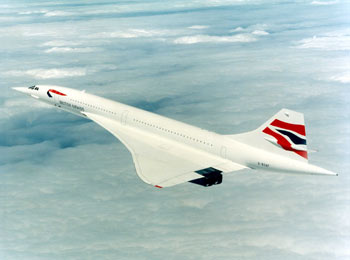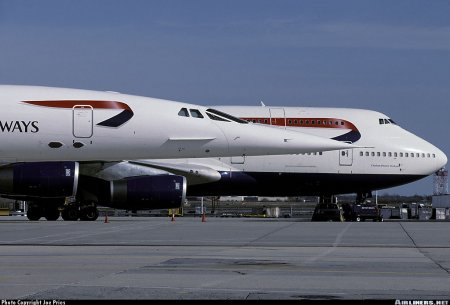



Only two supersonic passenger airliners have operated commercially, and the Concorde supersonic transport (SST) was the more successful one of them. First flown in 1969, commercial flights by British airways and Air France commenced in 1976 and continued for 27 years. It regularly flew from London Heathrow (British Airways) and Paris Charles de Gaulle (Air France) to New York JFK and Washington Dulles. It set many records, including circumnavigating the world in a time of 31 hours 27 minutes 49 seconds. It also employed a trademark droop nose for visibility to pilots on approach. Concorde had an average cruise speed of Mach 2.02 (2.02 times the speed of sound, about 2,140 km/h or 1,330 mph).
In the late 1950s, the United Kingdom, France, United States and Soviet Union were considering developing supersonic transport. Britain's Bristol Aeroplane Company and France's Sud Aviation were both working on designs, largely funded by their respective governments. The designs were both ready to start prototype construction in the early 1960s, but the cost was so great that the British government made it a requirement that BAC look for international co-operation. Approaches were made to a number of countries, but only France showed real interest. The development project was negotiated as an international treaty between the two countries. By this time, both companies had been merged into new ones, thus the Concorde project was between the British Aircraft Corporation and Aerospatiale.

Concorde vs Boeing 747
The new consortium secured orders for over 100 of the long-range jets from the premier airlines of the day, including Pan Am, Air France, Panair do Brasil, Japan Airlines, Lufthansa, Singapore Airlines, American Airlines, Air Canada, Iran Air, etc.
When the aircraft was fully tested by 1973 however, a combination of factors(the oil crisis, environmental concerns, etc.) led to a sudden number of order cancellations.
In the end, Only Air France and British Airways took up their orders.
Passenger experience on Concorde differed in many ways from that on subsonic commercial airliners. British Airways and Air France configured the passenger cabin as a single class with around 100 seats — four seats across with a central aisle. Headroom in the central aisle was barely six feet (1.8 m) and the leather seats were unusually narrow with legroom comparable to economy class on large airliners. With almost no room for overhead storage, carry-on luggage was severely restricted. Unlike the Boeing 747, video entertainment, rotating or reclining seats and walking areas were absent from Concorde.

Inside a Concorde
However, the flight time from London to New York of approximately 3.5 hrs compensated for the lack of those features. There was usually a plasma display at the front of the cabin showing the altitude, the air temperature and the current speed in both miles per hour and Mach number.
To make up for these missing "comfort" features, a high level of passenger service was maintained. Meals were served using specially designed compact Wedgwood crockery with short silver cutlery.
The experience of passing through the sound barrier was less dramatic than might be expected. The moment, accompanied by a slight surge in acceleration, was announced by one of the pilots. On certain early evening transatlantic flights departing from Heathrow or Paris, it was possible to take off just after sunset and catch up with the sun, landing in daylight; from the cockpit, the sun could be seen rising from the horizon in the west. This was much publicised by British Airways, who used the slogan "Arrive before you leave."
The social and environmental impact of extreme technology was an issue of debate during its flight time. It produced sonic boom over the areas it passed at supersonic speeds. These booms sound not different from thunder. Hence the flight of the concorde over residential areas was very restricted. Normally, it flew over oceans and seas to prevent this.

On fire
On 25 July 2000, Air France Flight 4590 crashed in Gonesse, France, killing all 100 passengers and nine crew on board the flight, and four people on the ground. It was the first and only fatal incident involving the type.
According to the official investigation conducted by the French accident investigation bureau, it was caused by a titanium strip, part of a thrust reverser, that fell from a Continental Airlines DC-10 that had taken off about four minutes earlier. This metal fragment punctured a tyre on the left main wheel bogie. The tyre exploded, and a piece of rubber hit the fuel tank and broke an electrical cable. So much for a piece of metal.
On 10 April 2003, British Airways and Air France simultaneously announced that they would retire Concorde later that year. They cited low passenger numbers following the 25 July 2000 crash, the slump in air travel following 9/11 and rising maintenance costs.
It has been suggested that Concorde was not withdrawn for the reasons usually given, and that the airlines discovered during the grounding that Concorde's first class passengers were loyal to the airlines, and carrying them on subsonic aircraft gave greater revenue and that this was the real reason for the withdrawal from service.

Last flight
The Concorde's enigma was such that an overflight would frequently temporarily halt day-to-day business. It was usually referred to by the British as simply "Concorde" and the French as "le Concorde". As a symbol of national pride, a plane from the British Airways fleet made occasional flypasts at selected Royal events, major airshows and other special occasions, sometimes in formation with the Red Arrows. On the final day of commercial service, public interest was so great that grandstands were erected at London's Heathrow Airport to manage a view of the final arrivals. Crowds filled the boundary road around the airport along with extensive media coverage.

The Concorde being towed through New York harbour, to the "Intrepid Sea, Air and Space Museum" on the Hudson River.
Thirty-seven years after her first test flight, Concorde was announced the winner of the Great British Design Quest, organised by the BBC and the Design Museum. In total, 20 Concordes were built, six for development and 14 for commercial service.

3 comments:
Nice review.
Concorde Accident Investigation : http://flightfield.com/index.php/flight-video?task=viewcategory&cat_id=18
I am so grateful to find your Air cargo post. I have bookmarked this website and I will keep visiting you for further such interesting posts
Customs Compliance Service Provider | International Air & Sea Transporters | Bangalore Logistics Companies
Post a Comment